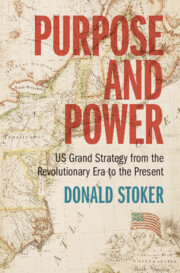Book contents
- Purpose and Power
- Purpose and Power
- Copyright page
- Dedication
- Contents
- Figures
- Maps
- Abbreviations
- Thinking about Grand Strategy in Peace and War
- Part I From Backwater to Great Power
- Part II From Great Power to Superpower
- 7 Stepping upon the Global Stage, 1913–1921
- 8 The Interwar Interlude, 1921–1939
- 9 Moving Astride the World: The Second World War, 1939–1945
- 10 The Hot Peace and the Korean War, 1945–1953
- 11 The Hot Peace: The Eisenhower, Kennedy, And Johnson Years, 1953–1969
- 12 The Vietnam War, 1961–1969
- 13 Détente and Defeat: Nixon, Ford, and Vietnam, 1969–1977
- 14 For Want of a Vision: The Carter Years, 1977–1981
- 15 Winning the Hot Peace: Reagan’s Great-Power Competition, 1981–1990
- Part III The Post–Cold War World
- Part IV Retreat and Defeat
- Acknowledgements
- Notes
- Index
10 - The Hot Peace and the Korean War, 1945–1953
from Part II - From Great Power to Superpower
Published online by Cambridge University Press: 11 January 2024
- Purpose and Power
- Purpose and Power
- Copyright page
- Dedication
- Contents
- Figures
- Maps
- Abbreviations
- Thinking about Grand Strategy in Peace and War
- Part I From Backwater to Great Power
- Part II From Great Power to Superpower
- 7 Stepping upon the Global Stage, 1913–1921
- 8 The Interwar Interlude, 1921–1939
- 9 Moving Astride the World: The Second World War, 1939–1945
- 10 The Hot Peace and the Korean War, 1945–1953
- 11 The Hot Peace: The Eisenhower, Kennedy, And Johnson Years, 1953–1969
- 12 The Vietnam War, 1961–1969
- 13 Détente and Defeat: Nixon, Ford, and Vietnam, 1969–1977
- 14 For Want of a Vision: The Carter Years, 1977–1981
- 15 Winning the Hot Peace: Reagan’s Great-Power Competition, 1981–1990
- Part III The Post–Cold War World
- Part IV Retreat and Defeat
- Acknowledgements
- Notes
- Index
Summary
The Cold War, or Hot Peace, now descended. The US, under Harry Truman, found itself taking on the role of global leader for the first time. It faced a shattered world and an aggressive Soviet Union under Josef Stalin. Truman launched the Truman Doctrine to help democracies under threat, and the Marshall Plan to help an economically prostrate Europe. George F. Kennan analyzed Soviet behavior in his Long Telegram and “X” article and gave us the strategy of containment. The US responded to Soviet aggression with the Berlin Airlift, joining NATO, and developing NSC 68. Communist aggression broke into the open in 1950 when North Korea invaded South Korea. Truman intervened, and then put the UN and the idea of collective security to the test by obtaining UN support for South Korea, something made possible by the Soviet boycott of the security council. General Douglas MacArthur’s amphibious landing at Inchon destroyed the North Korean invasion. Truman then ordered MacArthur to invade North Korea, having decided upon this before the invasion. Mao Tse-Tung’s Communist China intervened in support of North Korea and pushed the US forces back to South Korea. A bloody back-and-forth war ensued and extended negotiations eventually ended the conflict in 1953.
Keywords
- Type
- Chapter
- Information
- Purpose and PowerUS Grand Strategy from the Revolutionary Era to the Present, pp. 344 - 389Publisher: Cambridge University PressPrint publication year: 2024



